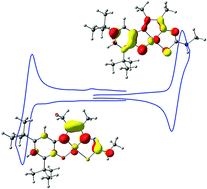Nickel(ii) radical complexes of thiosemicarbazone ligands appended by salicylidene, aminophenol and aminothiophenol moieties†
Abstract
The nickel(II) complexes of three unsymmetrical thiosemicarbazone-based ligands featuring a sterically hindered salicylidene (1), aminophenol (2) or thiophenol (3) moiety were synthesized and structurally characterized. The metal ion lies in an almost square planar geometry in all the complexes. The cyclic voltammetry (CV) curve of 1 shows an irreversible oxidation wave at Eap = 0.49 V, which is assigned to the phenoxyl/phenolate redox couple. The CV curves of 2 and 3 display a reversible one-electron oxidation wave (E1/2 = 0.26 and 0.22 V vs. Fc+/Fc, respectively) and an one-electron reduction wave (E1/2 = −1.55 and −1.46 V, respectively). The cations 2+ and 3+ as well as the anions 2− and 3− were generated. The EPR spectra of the cations in THF show a rhombic signal at g1 = 2.034, g2 = 2.010 and g3 = 1.992 (2+) and g1 = 2.069, g2 = 2.018, g3 = 1.986 (3+) that is consistent with a main radical character of the complexes. The difference in anisotropy is assigned to the different nature of the radical, iminosemiquinonate vs. iminothiosemiquinonate. The anions display an isotropic EPR signal at giso = 2.003 (2+) and 2.006 (3+), which is indicative of a main α-diimine radical character of the compounds. Both the anions and cations exhibit charge transfer transitions of low to moderate intensity in their visible spectrum. Quantum chemical calculations (B3LYP) reproduce both the g-values and Vis-NIR spectra of the complexes. The radical anions readily react with dioxygen to give the radical cations. 2+ catalyzes the aerobic oxidation of benzyl alcohol into benzaldehyde.


 Please wait while we load your content...
Please wait while we load your content...